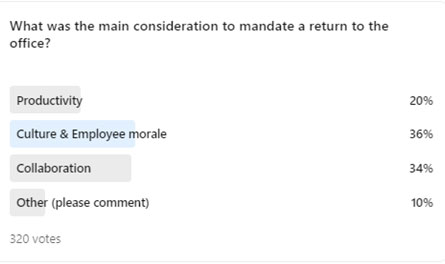According to predictions, 90% of companies in Australia and New Zealand will require employees to return to the office in 2023, even for those currently on hybrid schedules. Within the next six months, it is anticipated that:
- 13% of companies will shift to full-time in-office work,
- 40% will require four days a week,
- and 31% will require three days a week.
This indicates a shift towards a more office-centric working model, with organisations seeking to strike a balance between remote and in-person work. As fully embedded talent experts, we have witnessed a wide range of approaches taken by businesses when implementing a return to work in their respective industries. These experiences offer intriguing perspectives and present insightful challenges for organisations to navigate:
- Mandating or recommending a return
One noticeable distinction we have observed is the varying approaches to mandating or recommending a return to the office. Outside of our own observations in the market, the Commonwealth Bank and NAB are amongst those making the headlines with their plans to return. While some employers have mandated a full return to work, others have opted to encourage their teams through value-added initiatives. For example, implementing designated team days in the office where the entire team gathers for meetings and collaborative sessions. In some cases, employers have mandated a return without strict monitoring, allowing employees greater autonomy and flexibility.
Considerations for mandating the return to work also differ across industries. Certain sectors, such as those involving shift work or requiring strict security measures or face-to-face client interactions, have traditionally had limited flexibility in terms of work location. Consequently, the decision to mandate a return to the office may be more prevalent in these industries.
- Number of days in office
The number of days mandated for in-office work also varies. Some organisations have embraced hybrid work models, advertising roles as hybrid to attract a broader pool of applicants, while still limiting remote work to just one day per week. Other companies have adopted a more flexible approach, requiring a certain percentage of office presence every fortnight or month, allowing employees greater freedom in shaping their work-home balance.
Interestingly, companies that have mandated more days in the office have experienced a higher drop-out rate among candidates during the hiring process. This observation was also reflected in recent research by Unispace, which found that 42% of companies that mandated a return now report higher levels of attrition. It appears that the desired balance for many candidates is three days of remote work and two days in the office. Organisations that have enforced a full return to the office have encountered increased turnover rates as employees seek alternative opportunities offering more flexible work arrangements.
- Challenges returning
Facilitating the return to the office has posed its own set of challenges for organisations. Some employees returning to the office have struggled to find available workspace, leading to a sense of disarray and frustration. Additionally, employees working in the office have had to manage calls with colleagues who continue to work remotely, presenting communication and collaboration hurdles. Furthermore, certain roles have been explicitly advertised as “fully remote” during the pandemic, rendering them exempt from the return-to-office mandate. However, companies still open to hiring fully remote employees often require an approved business case to justify this arrangement.
These observations highlight the complex and multifaceted nature of the return-to-work transition. Organisations must carefully consider industry-specific requirements, employee preferences, and the potential impact on talent acquisition and retention.










